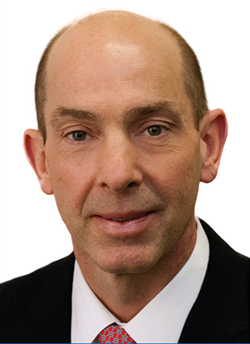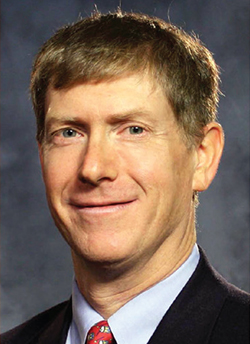2017 Power Broker
Utilities
Aligning the Carriers
“Since Yogi has managed our property program, we have been able to decrease our rates, our premiums, and improve our terms and conditions,” said one compliance manager.
“For example, we had carriers initially all over the map relative to the deductible for our combustion turbine. Yogi worked very hard to get all of the carriers aligned and decreased the overall deductible amount.
“The insurance program that we have today is a tribute to the hard work and dedication of Yogi to our account.”
The nature of the power business is that in many cases, clients are working on multiple projects at the same time.
“Recently, we successfully bound five projects that needed separate limits as well as their own separate earthquake limits,” said an insurance manager.
“Yogi was able to successfully work with our insurance markets and negotiate favorable terms and pricing with all programs binding on the same date.”
Sometimes service is just the little things. “Yogi came in fresh to our account,” said a risk manager.
“I was new to the position too. He found new markets and new endorsements to enhance our coverage. Things we didn’t know we were missing, or didn’t know were available.”
Insuring the Grid
New rules for power generators came into effect in 2016, imposing a system of rewards and penalties for generators in meeting supply obligations. If a generator can’t supply the power promised, it has to pay for the wholesaler to get that juice on the spot market. That created a new exposure for utilities.
The key wholesaler implementing the new system was PJM, the regional power transmission organization for the central Atlantic and some Midwestern states.
“Brian helped my firm navigate the new capacity performance requirements of PJM,” said one manager of insurance and financial services. “He was able to develop and deliver an effective solution. He maintained his commitment to meet our company’s objectives.”
Another PJM supplier concurred.
“Brian helped us obtain generator-outage insurance for our power-production assets in the PJM market to cover nonperformance risk associated with PJM’s new market rules on capacity performance,” said one client’s director of resource planning. “This was the first such insurance for us and it was seamless.”
As with the capacity performance mandates, DeBruin and his team made a practice of seeing broad issues in individual situations. In a different market, a client sought protection for a U.S. utility with assets overseas. DeBruin had to manuscript coverage, but was then able to develop broader language for use in other cases.
Nuclear Certainty
Nuclear matters within one state or one country are tough enough, but Charles Hardie and his team won accolades for handling a shipment arriving in the U.S. by sea, across the country by road, and then off to another continent by air.
“The shipment was already en route when it was realized there needed to be foreign suppliers and transporters insurance in place, but we had none,” said the director of insurance.
“Chip had to work with American Nuclear Insurance (ANI) to place a coverage,” while the shipment was on the move. But a gap was identified in liability coverage on the route.
“The shipment may have been delayed or turned around if we did not secure coverage right away. Fortunately, Chip and his colleagues were able to compile all necessary information and negotiate with ANI to put a policy in place. I believe this was only successful because of our reputation in the industry, the liability knowledge base in the UK, and Chip’s outstanding relationship with ANI.”
Hardie was also recognized for his work with decommissioned facilities. “As shut-down, fully decommissioned facilities, our risks are much different than our counterparts who are operating,” said one CFO. “Chip developed and recommended a comprehensive plan to lobby Nuclear Property Insurers on our behalf to get them to recognize our unique risk profile in an effort to better align our premium costs with our risks.
“We were able to secure more robust coverage for a lower cost.”
Insuring the Carrot and the Stick
Tom Markovic was also called upon to help utility clients navigate the ins and outs of new incentive and penalty rules for power generators.
“Tom developed new insurance for the emerging, significant risk in the power market,” said one risk analyst.
“He placed the risk for three separate portfolios in time to meet the inception date of the new capacity rules, June 1, 2016. Tom handled the intricacies of our bilateral agreements to make sure we were covered correctly and that the policy captured the changing nature of the new market. For example, he extended coverage to 365 days per each event due to lack of interest from the traditional property insurers to cover this exposure under the business interruption policies.”
Another client explained that “the insurance industry is used to limiting coverage only for 90 consecutive days, Tom was able to negotiate a 365 day per event coverage, which helped us mange the risk exposure.”
This was a whole new type of coverage, said one vice president of operations.
“It was not a modification of an existing policy but rather the development of a new coverage. Tom’s influence with the insurance companies was essential to help them understand their risk and exposure to, primarily, weather-driven events in the power market. Providers were all over the map trying to design a new policy. Tom helped them better understand the associated risks and appropriate pricing levels.”
Navigating Power Generation Challenges
The age of coal is clearly waning, but by no means is it over just yet. Indeed the overall decline of the industry makes those who are facile in it all the more valuable to their clients.
“This year I worked with Mike on a renewal property program for two newly acquired coal-fired electrical generation plants,” said one risk manager.
“One of these facilities is about 50 years old and experienced losses in the year or so prior to our acquisition. There were several challenges in this renewal, including most of the existing insurers did not want to continue with the risk.
“Mike navigated us through all of the issues and was able to work with a new insurer and negotiate a 25 percent premium reduction. He clearly demonstrated his understanding of risks associated with power generation, and worked very well with the underwriters and their engineers in placing our insurance.”
Capability in a sunset sector does not mean Perron is hidebound. Quite to the contrary: Another client credits him with thinking way outside the box.
“For almost 20 years we have had a panel of underwriters,” said the CFO of a utility. “All on his own Mike suggested that we shift instead to a single carrier, and one outside the panel. We always felt that there was security and flexibility in the panel, but Mike demonstrated that one can be more nimble and responsive than a consensus of six. In the end, we got better coverage and a 20 percent reduction in premium.”
Managing the Markets
It is always good for clients when brokers can dig and find better prices or terms; it is even better when a broker can get the underwriters to vie for the business and bring the better rates and terms rather than needing to dig for them at all. That is one of Jennifer Spencer’s skills, said one director of insurance. “She really knew how to create competition among the carriers. We definitely benefited from that this year.”
Another situation was quite different. Spencer was not calling the tune, but having to play musical chairs to meet a client’s obligation under an outside agreement. The client was in the process of making an acquisition.
Under the terms of the deal, the existing liabilities of the client company, including all its historical liabilities, had to be isolated from the newly combined entity. That meant that Spencer had to convert the existing placement into a long-term run-off policy and at the same time create a new continuing program for the new combined entity. Both had to come into force immediately upon the closing of the deal. All in all a complex and expensive proposition, but one that was mandated by the terms of the acquisition.
Spencer got it done. She negotiated an endorsement to the existing program that established a six-year tail liability for the heritage liabilities. Sunset provisions were made in case the company was acquired, and limits set for possible future costs. The terms of the deal were met and the actual additional costs were less than what had been anticipated.

















